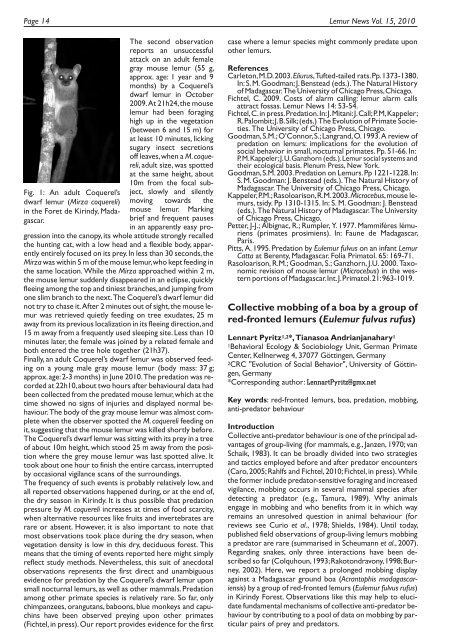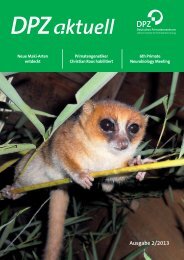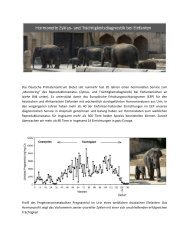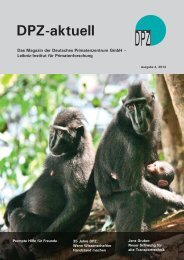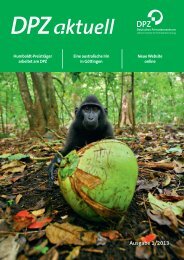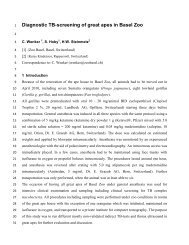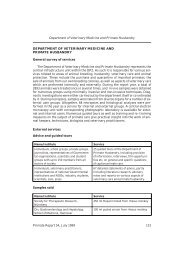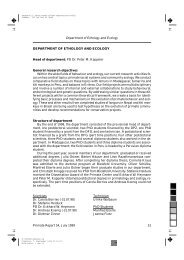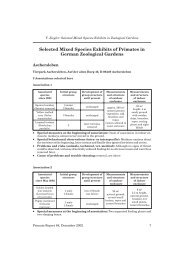Vol. 15 - Deutsches Primatenzentrum
Vol. 15 - Deutsches Primatenzentrum
Vol. 15 - Deutsches Primatenzentrum
You also want an ePaper? Increase the reach of your titles
YUMPU automatically turns print PDFs into web optimized ePapers that Google loves.
Page 14 Lemur News <strong>Vol</strong>. <strong>15</strong>, 2010<br />
Fig. 1: An adult Coquerel’s<br />
dwarf lemur (Mirza coquereli)<br />
in the Foret de Kirindy, Madagascar.<br />
The second observation<br />
reports an unsuccessful<br />
attack on an adult female<br />
gray mouse lemur (55 g,<br />
approx. age: 1 year and 9<br />
months) by a Coquerel’s<br />
dwarf lemur in October<br />
2009.At 21h24,the mouse<br />
lemur had been foraging<br />
high up in the vegetation<br />
(between 6 and <strong>15</strong> m) for<br />
at least 10 minutes, licking<br />
sugary insect secretions<br />
off leaves,when a M.coquereli,<br />
adult size, was spotted<br />
at the same height, about<br />
10m from the focal subject,<br />
slowly and silently<br />
moving towards the<br />
mouse lemur. Marking<br />
brief and frequent pauses<br />
in an apparently easy pro-<br />
gression into the canopy, its whole attitude strongly recalled<br />
the hunting cat, with a low head and a flexible body, apparently<br />
entirely focused on its prey.In less than 30 seconds,the<br />
Mirza was within 5 m of the mouse lemur,who kept feeding in<br />
the same location. While the Mirza approached within 2 m,<br />
the mouse lemur suddenly disappeared in an eclipse, quickly<br />
fleeing among the top and tiniest branches,and jumping from<br />
one slim branch to the next.The Coquerel’s dwarf lemur did<br />
not try to chase it.After 2 minutes out of sight,the mouse lemur<br />
was retrieved quietly feeding on tree exudates, 25 m<br />
away from its previous localization in its fleeing direction,and<br />
<strong>15</strong> m away from a frequently used sleeping site. Less than 10<br />
minutes later, the female was joined by a related female and<br />
both entered the tree hole together (21h37).<br />
Finally, an adult Coquerel’s dwarf lemur was observed feeding<br />
on a young male gray mouse lemur (body mass: 37 g;<br />
approx.age:2-3 months) in June 2010.The predation was recorded<br />
at 22h10,about two hours after behavioural data had<br />
been collected from the predated mouse lemur,which at the<br />
time showed no signs of injuries and displayed normal behaviour.The<br />
body of the gray mouse lemur was almost complete<br />
when the observer spotted the M. coquereli feeding on<br />
it,suggesting that the mouse lemur was killed shortly before.<br />
The Coquerel’s dwarf lemur was sitting with its prey in a tree<br />
of about 10m height, which stood 25 m away from the position<br />
where the grey mouse lemur was last spotted alive. It<br />
took about one hour to finish the entire carcass,interrupted<br />
by occasional vigilance scans of the surroundings.<br />
The frequency of such events is probably relatively low, and<br />
all reported observations happened during, or at the end of,<br />
the dry season in Kirindy. It is thus possible that predation<br />
pressure by M. coquereli increases at times of food scarcity,<br />
when alternative resources like fruits and invertebrates are<br />
rare or absent. However, it is also important to note that<br />
most observations took place during the dry season, when<br />
vegetation density is low in this dry, deciduous forest. This<br />
means that the timing of events reported here might simply<br />
reflect study methods. Nevertheless, this suit of anecdotal<br />
observations represents the first direct and unambiguous<br />
evidence for predation by the Coquerel’s dwarf lemur upon<br />
small nocturnal lemurs, as well as other mammals. Predation<br />
among other primate species is relatively rare. So far, only<br />
chimpanzees, orangutans, baboons, blue monkeys and capuchins<br />
have been observed preying upon other primates<br />
(Fichtel, in press). Our report provides evidence for the first<br />
case where a lemur species might commonly predate upon<br />
other lemurs.<br />
References<br />
Carleton,M.D.2003.Eliurus,Tufted-tailed rats.Pp.1373-1380.<br />
In:S.M.Goodman;J.Benstead (eds.). The Natural History<br />
of Madagascar.The University of Chicago Press,Chicago.<br />
Fichtel, C. 2009. Costs of alarm calling: lemur alarm calls<br />
attract fossas. Lemur News 14: 53-54.<br />
Fichtel,C.in press.Predation.In:J.Mitani:J.Call;P.M,Kappeler;<br />
R.Palombit;J.B.Silk;(eds.) The Evolution of Primate Societies.<br />
The University of Chicago Press, Chicago.<br />
Goodman,S.M.;O’Connor,S.;Langrand,O.1993.A review of<br />
predation on lemurs: implications for the evolution of<br />
social behavior in small, nocturnal primates. Pp. 51-66. In:<br />
P.M.Kappeler;J.U.Ganzhorn (eds.).Lemur social systems and<br />
their ecological basis. Plenum Press, New York.<br />
Goodman,S.M.2003.Predation on Lemurs.Pp 1221-1228.In:<br />
S. M. Goodman: J. Benstead (eds.). The Natural History of<br />
Madagascar. The University of Chicago Press, Chicago.<br />
Kappeler,P.M.;Rasoloarison,R.M.2003.Microcebus,mouse lemurs,<br />
tsidy. Pp 1310-13<strong>15</strong>. In: S. M. Goodman: J. Benstead<br />
(eds.).The Natural History of Madagascar.The University<br />
of Chicago Press, Chicago.<br />
Petter, J-J.; Albignac, R.; Rumpler, Y. 1977. Mammifères lémuriens<br />
(primates prosimiens). In: Faune de Madagascar,<br />
Paris.<br />
Pitts, A. 1995. Predation by Eulemur fulvus on an infant Lemur<br />
Catta at Berenty, Madagascar. Folia Primatol. 65: 169-71.<br />
Rasoloarison, R.M.; Goodman, S.; Ganzhorn, J.U. 2000. Taxonomic<br />
revision of mouse lemur (Microcebus) in the western<br />
portions of Madagascar.Int.J.Primatol.21:963-1019.<br />
Collective mobbing of a boa by a group of<br />
red-fronted lemurs (Eulemur fulvus rufus)<br />
Lennart Pyritz 1,2*, Tianasoa Andrianjanahary 1<br />
1Behavioral Ecology & Sociobiology Unit, German Primate<br />
Center, Kellnerweg 4, 37077 Göttingen, Germany<br />
2CRC "Evolution of Social Behavior", University of Göttingen,<br />
Germany<br />
*Corresponding author: LennartPyritz@gmx.net<br />
Key words: red-fronted lemurs, boa, predation, mobbing,<br />
anti-predator behaviour<br />
Introduction<br />
Collective anti-predator behaviour is one of the principal advantages<br />
of group-living (for mammals, e.g., Janzen, 1970; van<br />
Schaik, 1983). It can be broadly divided into two strategies<br />
and tactics employed before and after predator encounters<br />
(Caro,2005;Rahlfs and Fichtel, 2010;Fichtel, in press). While<br />
the former include predator-sensitive foraging and increased<br />
vigilance, mobbing occurs in several mammal species after<br />
detecting a predator (e.g., Tamura, 1989). Why animals<br />
engage in mobbing and who benefits from it in which way<br />
remains an unresolved question in animal behaviour (for<br />
reviews see Curio et al., 1978; Shields, 1984). Until today,<br />
published field observations of group-living lemurs mobbing<br />
a predator are rare (summarised in Scheumann et al., 2007).<br />
Regarding snakes, only three interactions have been described<br />
so far (Colquhoun,1993;Rakotondravony,1998;Burney,<br />
2002). Here, we report a prolonged mobbing display<br />
against a Madagascar ground boa (Acrantophis madagascariensis)<br />
by a group of red-fronted lemurs (Eulemur fulvus rufus)<br />
in Kirindy Forest. Observations like this may help to elucidate<br />
fundamental mechanisms of collective anti-predator behaviour<br />
by contributing to a pool of data on mobbing by particular<br />
pairs of prey and predators.


